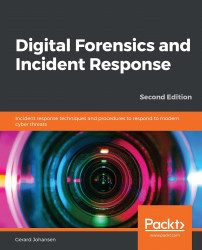Planning for an incident is critical. Equally critical is properly managing an incident. This involves several elements that each CSIRT must address during the life of an incident. Proper logistics provides the necessary elements for the CSIRT to function. Having strategies to communicate incident information to leadership, third parties, and customers keeps those stakeholders informed, lessens speculation, and ensures compliance requirements are met. Incident investigation allows the CSIRT to properly identify the attack, identify the scope, and limit damage via a proper containment strategy. Finally, these elements are all part of eradicating an adversary's ability to access a network and helping an organization to return to normal. As was stated at the beginning: Everyone has a plan until they get hit in the face
. The real value of a CSIRT to an organization is...

Digital Forensics and Incident Response - Second Edition
By :
Digital Forensics and Incident Response - Second Edition
By:
Overview of this book
An understanding of how digital forensics integrates with the overall response to cybersecurity incidents is key to securing your organization's infrastructure from attacks. This updated second edition will help you perform cutting-edge digital forensic activities and incident response.
After focusing on the fundamentals of incident response that are critical to any information security team, you’ll move on to exploring the incident response framework. From understanding its importance to creating a swift and effective response to security incidents, the book will guide you with the help of useful examples. You’ll later get up to speed with digital forensic techniques, from acquiring evidence and examining volatile memory through to hard drive examination and network-based evidence. As you progress, you’ll discover the role that threat intelligence plays in the incident response process. You’ll also learn how to prepare an incident response report that documents the findings of your analysis. Finally, in addition to various incident response activities, the book will address malware analysis, and demonstrate how you can proactively use your digital forensic skills in threat hunting.
By the end of this book, you’ll have learned how to efficiently investigate and report unwanted security breaches and incidents in your organization.
Table of Contents (22 chapters)
Preface
Section 1: Foundations of Incident Response and Digital Forensics
 Free Chapter
Free Chapter
Understanding Incident Response
Managing Cyber Incidents
Fundamentals of Digital Forensics
Section 2: Evidence Acquisition
Collecting Network Evidence
Acquiring Host-Based Evidence
Forensic Imaging
Section 3: Analyzing Evidence
Analyzing Network Evidence
Analyzing System Memory
Analyzing System Storage
Analyzing Log Files
Writing the Incident Report
Section 4: Specialist Topics
Malware Analysis for Incident Response
Leveraging Threat Intelligence
Hunting for Threats
Assessment
Other Books You May Enjoy
Appendix
Customer Reviews

